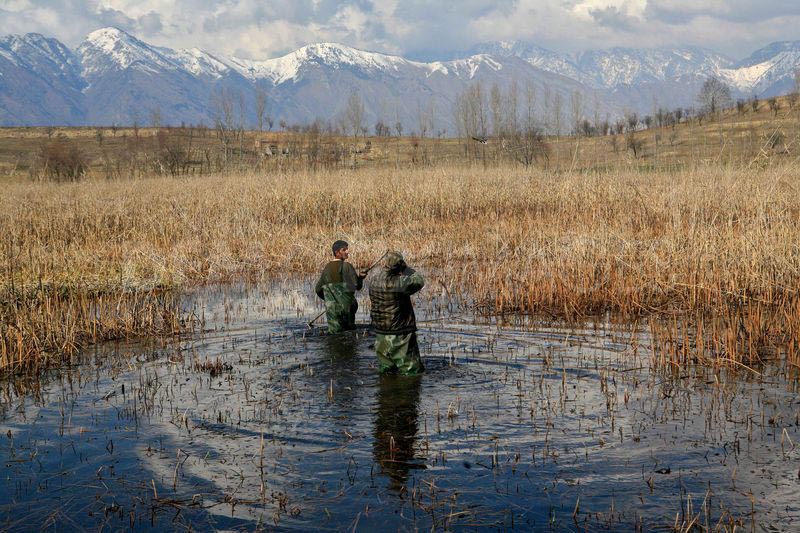
‘Over 23% Water Bodies In J&K Have ‘Dried Up, Beyond Repair’
Srinagar- The maiden survey released by the Ministry of Jal Shakti has presented a dismal picture of the water bodies in Jammu and Kashmir, revealing that over 23 percent of them have ‘dried up and are beyond repair’,
According to the first Census of Water Bodies released by the Ministry, there are over 24 lakh water bodies across the country, and over 9,700 water bodies in J&K, of which over 76 per cent are ‘in use’.
As per the census, a total of 9,765 water bodies have been enumerated in J&K, out of which 99.2% (9,687) are in rural areas and the remaining 0.8% (78), are in urban areas, noting that the majority of the water bodies are ponds.
The water bodies include 5256 ponds, 179 tanks, 37 lakes, 441 reservoirs, 29 water conservation schemes/percolation tanks/ check dams and 3832 others.
“Out of ‘in use’ water bodies, a major proportion of water bodies are used for domestic/ drinking purposes followed by irrigation purposes,” the report says.
The report further revealed that the “state” has reported encroachment in 103 water bodies out of all the enumerated water bodies, out of which 95 are ponds
Out of all water bodies, 1.2% (122) are covered in the District Irrigation Plan/State Irrigation Plan.
Among these 44.3% (54) are reservoirs, 31.1% (38) are ponds and the remaining 24.6% (30) are tanks and water conservation schemes/percolation tanks/check dams. Out of ‘in use’ water bodies, 93.0% (6,968) are benefitting one (01) city/town, 6.8% (510) water bodies are fulfilling requirements of 2-5 cities/ towns and the remaining 0.2% (15) water bodies are benefitting more 177 than five (05) cities/towns.
The census was launched under the centrally sponsored scheme, “Irrigation Census” in convergence with the 6th Minor Irrigation Census in order to have a comprehensive national database of all water bodies.
It provides a comprehensive inventory of India’s water resources, including natural and man-made water bodies like ponds, tanks, lakes, and more, and to collect data on the encroachment of water bodies.
The census also highlighted disparities between rural and urban areas and varying levels of encroachment and revealed crucial insights into the country’s water resources.
The census has cited that out of 2036 ponds that are not in use, 974 are dried up, 21 have turned into construction, 19 because of salinity, 193 are destroyed beyond repair, one each is affected due to industry and salinity, and 827 are others.
The report further reveals that there are 36% (3,519) natural and 64% (6,246) man-made water bodies. Out of 3,519 natural water bodies, 99.5% (3,502) are located in rural areas whereas the remaining 0.5% (17) are located in urban areas.
“Out of 6,246 man-made water bodies, 99% (6,185) water bodies are located in rural areas and the remaining 1% (61) are located in urban areas. Most of the man-made water bodies have original cost of construction up to Rs.50,000/,” it noted.
As per the census, out of 9765 water bodies, 3519 are natural, and 6246 are man-made.
According to the census, 9209 water bodies in J&K, and Ladakh have never been repaired. Only 115 water bodies were repaired before 2009. In 2009, 11 water bodies were repaired; 51 in 2010; 20 in 2011; 34 in 2012; 71 in 2013; 38 in 2014; 59 in 2015; 24 in 2016; 54 in 2017; 34 in 2018, and 45 were repaired after 2018.
The census further reveals that over 2272 not-in-use water bodies in J&K and Ladakh, including 2026 ponds, 29 tanks, 6 Lakes, 26 reservoirs, 6 water conservation schemes/percolation tanks/ check dams, and 169 others. Further, out of 9765 water bodies, 5016 are public owned, and 4749 are privately owned.
As per the census, 7431 water bodies are in use in rural areas, out of which 718 are used for irrigation, 12 for industrial, 97 for pisciculture, 5935 are for domestic/ drinking, 19 are recreation, 49 are for religious, 129 are for groundwater recharge, 472 are others.
In the urban area, 62 water bodies are in use, one for irrigation, 51 for domestic/drinking, 7 for religious, and 3 for others.
The information on all important aspects of the water bodies including their type, condition, status of encroachments, use, storage capacity, status of filling up of storage, etc was collected. It covered all the water bodies located in rural as well as urban areas that are in-use or not in-use.
The census also took into account all types of uses of water bodies like irrigation, industry, pisciculture, domestic/ drinking, recreation, religion, ground water recharge etc. Census has been successfully completed and the All India and State-wise reports have been published.
Follow this link to join our WhatsApp group: Join Now
Be Part of Quality Journalism |
Quality journalism takes a lot of time, money and hard work to produce and despite all the hardships we still do it. Our reporters and editors are working overtime in Kashmir and beyond to cover what you care about, break big stories, and expose injustices that can change lives. Today more people are reading Kashmir Observer than ever, but only a handful are paying while advertising revenues are falling fast. |
| ACT NOW |
| MONTHLY | Rs 100 | |
| YEARLY | Rs 1000 | |
| LIFETIME | Rs 10000 | |













